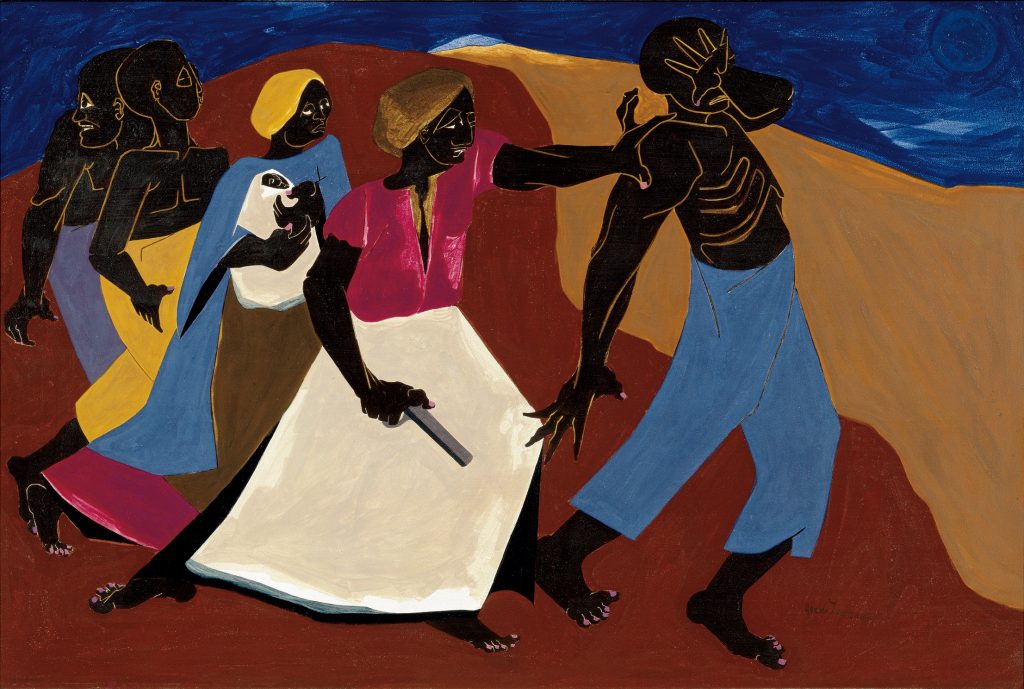Forward (work of art)
Artwork Info
Key Ideas
- This painting depicts Harriet Tubman leading a group of enslaved people in the South to freedom. In 1849 she escaped enslavement in Maryland using the Underground Railroad. Tubman returned to help other enslaved people escape to the North.
- Jacob Lawrence was one of the first nationally recognized African American artists. His paintings depicted African American historical figures and contemporary life.
- Lawrence created this painting during the Civil Rights Movement of the late 1960s.
- Lawrence is best known for creating The Migration Series. This series of 60 panels depicts the Great Migration.
- In 1946 Lawrence taught a summer painting course at Black Mountain College, a liberal arts school in the North Carolina mountains.
Learn More
Jacob Lawrence was one of the first nationally recognized African American artists. His paintings depicted African American historical figures and contemporary life. He called his style “dynamic cubism.” He was inspired by his environment growing up in Harlem during the Great Depression.
All these people on the street, various colors, so much pattern, so much movement, so much color, so much vitality, so much energy.
Jacob Lawrence
Forward depicts Harriet Tubman leading a group of enslaved people to freedom. She is holding a revolver and urging the group forward. The figures surrounding her are shown to have expressions and gestures of both fear and resolution. In 1849 Tubman escaped enslavement in Maryland using the Underground Railroad. She returned to lead other enslaved people to freedom. According to her records, she rescued approximately 70 people during roughly 13 trips. She was an abolitionist, Civil War spy, and supporter of women’s suffrage. Lawrence completed this painting of Tubman in 1967 during the Civil Rights Movement. He portrayed Tubman as an example of moral courage and self-determination.
Lawrence lived in Harlem near the end of the Harlem Renaissance. This was an early 20th-century art movement in which New York City’s Harlem neighborhood became a Black cultural center. The Harlem Renaissance encouraged the creation of literature, music, stage performances, and art that celebrates Black culture. As a teenager Lawrence attended art classes taught by Charles Alston. Alston encouraged him to attend the Harlem Community Art Center, which was headed by Augusta Savage. Alston and Savage were American artists associated with the Harlem Renaissance. Savage helped Lawrence secure a position with the Works Progress Administration (WPA), where he met his wife Gwendolyn Knight Lawrence.
Lawrence’s best-known work is The Migration Series. It comprises 60 painted panels that depict the Great Migration. The Great Migration was the movement of six million African Americans out of the rural South to the industrialized cities of the North. Black Americans moved to escape racism and violence and to find better jobs and opportunities. Lawrence’s parents relocated from the South to the Northeast during the Great Migration.
I do not look upon the story of the Blacks in America as a separate experience to the American culture but as a part of the American heritage and experience as a whole.
Jacob Lawrence
In 1946 artist Josef Albers invited Lawrence to teach a painting course at Black Mountain College, a liberal arts college near Asheville, North Carolina. The school closed in 1957, but while it was open it emphasized the importance of the arts in learning. Lawrence and his wife were intrigued enough by Albers to risk leaving their home in Brooklyn, New York, to spend two months in the segregated South. Lawrence taught a painting course during the school’s 10-week Summer Institute. While Albers taught at the college, Gwendolyn sat in on his classes, studied sculpture, and taught a modern dance class.
tags: landscape, force, heroine, narrative, color
Additional Resources
Resources for Teachers
- Read a biography about Jacob Lawrence.
- View all 60 panels of The Migration Series.
- Watch a video about Lawrence’s The Migration Series.
Resources for Students
- Watch a video of Lawrence discussing his process and inspiration.
- Watch another video of the artist describing his ties to the Great Migration.
- Read a short article about Lawrence.
Images
-

Forward
A tempera painting of Harriet Tubman leading four enslaved people to freedom. Tubman is central in the painting, wearing a pink short-sleeved shirt and a white skirt. She holds a gun in her right hand and uses her left hand to push a figure forward. The figure being pushed forward is shirtless and wearing blue pants. Their left arm is held up, with their hand blocking their face. Three figures stand behind Tubman. The figure right behind Tubman holds a baby wrapped in a white blanket. The last two figures are shirtless, one wears yellow pants, and the other wears blue pants. The background is made up of red-brown, tan, and dark blue blocks of color.
